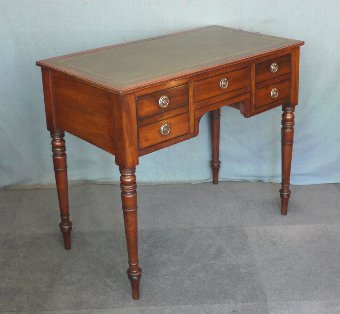featured item
antique victorian 6 drawer pollard oak partners writing table desk c1850 19th c

antiques available from other sellers in antique furniture > desks
-
![Mahogany Sheraton Revival Desk]() £2250.00
£2250.00mahogany sheraton revival desk Read more
Georgian Antiques -
![18th Century antique mahogany kneehole desk]() £1950.00
£1950.0018th century antique mahogany kneehole desk Read more
Martlesham Antiques -
![Large Late Victorian Chinese Chippendale-Style Mahogany Breakfront Desk]() £2250.00
£2250.00large late victorian chinese chippendale-style mahogany b... Read more
Georgian Antiques -
![Regency mahogany writing table]() £750.00
£750.00regency mahogany writing table Read more
Michael Armson (antiques) Ltd
- View other items in:
- antique furniture
- desks
Still not found something similar? Why not save a search and get a notification in your inbox when an matching antique is added to our ever-growing database?
Enter your email address to be sent alerts when new items are added to the site that match your search criteria

This gorgeous early Victorian antique Partners desk is crafted from beautiful pollard oak and dates from Circa 1850.
Our reference: A1864
Pollard Oak
Pollarding is a pruning system in which the upper branches of a tree are removed, promoting a dense head of foliage and branches. It has been common in Europe since medieval times and is practised today in urban areas worldwide, primarily to maintain trees at a predetermined height. The bole of the tree, constantly cut back over a period of years, will eventually form a lump, or ‘burr', which when sawn for veneer, gives a lovely grained, swirling figure.
The effect is similar to that of burr walnut with its distinctive speckled grain. Burrs, or ‘burls', are growths which appear on the side of tree trunks, resulting from a tree undergoing some form of stress. They may be caused by an injury, virus or fungus.
During the 19th century great strides were made in the mechanisation of cabinet making. Marc Isambard Brunel [ Isambard Kingdom's father] built the first steam driven saw mill, and invented a circular saw that could be used to cut veneers thinly and evenly for the first time. He also developed the first hydraulic veneer press. The figured wood cut from burrs and pollards is notoriously difficult to cut and lay: the wild grain which makes it so attractive results in a very delicate, brittle veneer. The new machines enabled the Victorian craftsmen to make the most of these beautiful timbers.
Antiques.co.uk Ref: KPQKREBXC
- Width (cm):
- 153
- Height (cm):
- 78
- Depth (cm):
- 107
Here on antiques co uk we love antiques and specialise in selling antiques. Even though this item was for sale and is now sold or otherwise now unavailable we have many more items for sale including vintage antiques, silver, tables, watches, jewellery and much more for your interiors and home.
Search all the antiques currently for sale on www.antiques co uk. Or why not consider selling your antiques and making sales more easily with us!
regent antiques limited
Regent Antiques Limited has 986 antiques for sale.
click here to see them all












